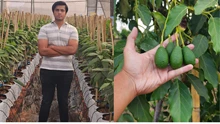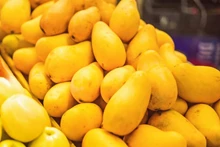
Rice is widely assumed to be an aquatic plant that thrives in standing water. Rice is not an aquatic plant; it can survive in water but not thrive in low oxygen environments (hypoxia). Under constant flooding, rice plants spend a lot of energy developing air pockets (aerenchyma tissue) in their roots. During the flowering phase, over 70% of rice root tips deteriorate.
Farmers also use an average of 15,000 liters of water to produce one kilogram of paddy, but water technologists at the Indian Agricultural Research Institute in New Delhi suggest that if adequate water management techniques are used, just 600 liters are required to produce the same quantity of rice. Given that rice cultivation consumes 45 percent of the country's total irrigation water, it's necessary to boost farming methods.
There are several interventions introduced for a sustainable approach to paddy cultivations. They are listed as follows:
Seed Replacement Rate (SRR)
The seed replacement rate (SRR) is a measure of how much of the cropped area is covered with high-quality seed. As a result, SRR has a direct impact on increasing productivity and increasing farmer income and is one of the methods for doubling farmer income.
Seed Treatment
Seed treatment can be done in three different ways: seed dressing, seed coating, and seed pelleting. Seed dressing is the most common type of seed treatment. In this method, the seed should be dressed with either a dry formulation or a wet one that gets treated with a slurry or liquid.
Dressings should be used on both the farm and in the industry. Seeds should be spread on a polyethylene sheet, and the required amount of chemicals should be sprinkled on top of the seeds and mechanically mixed by the farmers.
Line Sowing
Line sowing is a better option than broadcasting for paddy cultivation. Seeds are sowed in rows on the main field. Between lines, the spacing is 22.5 to 30 cm, while within a line, the spacing is 8 to 10 cm. The seed should be planted at least 3–4 cm deep.
System of Rice Intensification (SRI)
The system of rice intensification (SRI) involves cultivating rice with as much organic manure as possible, beginning with young seedlings planted singly at a wider spacing in a square pattern; occasional irrigation that keeps the soil moist but not flooded; and regular inter cultivation with a weeder that actively oxygenates the soil.
SRI isn't a pre-packaged, pre-programmed technology solution. It's more of a set of principles, a system for sustainably managing and saving resources by changing how land, seeds, water, nutrients, and human labor are used to boost productivity from a small but well-tended number of seeds.
SRI, as Father de Laulanié pointed out, is a collection of different beneficial practices. Paddy fields are not flooded under SRI but are kept damp during the vegetative period. After that, only one inch of water is kept. This method uses about half the amount of water that is generally used in conventional farming. Currently, over a million farmers throughout the world are experimenting with this method.
The paddy cultivation using the SRI method uses less water, needs less labor, and produces better yields. As a result, it is highly beneficial for small and marginal farmers. In the 1980s, Madagascar was the first country to develop SRI. China, Indonesia, Cambodia, Thailand, Bangladesh, Sri Lanka, and India are all putting it to the test as of now. During the 2003 Kharif season, SRI was tested in all 22 districts of Andhra Pradesh with positive results.
In SRI paddy cultivation, only 2 kg of seeds per acre are required. As a result, there are fewer plants per unit area (25 × 25 cm), compared to 20 kg of seeds per acre in conventional chemical-intensive paddy cultivation. (1 acre equals about 0.4 hectares.)
Comparison between SRI and the conventional method of rice cultivation:
|
Practices |
SRI |
Conventional Method |
|
Spacing |
25 × 25 cm |
15 × 10 cm |
|
No. of plants per sq. m |
16 |
66 |
|
No. plants per acre |
64,000 |
792,000 |
|
Seed requirement per acre |
2 kg |
20 kg |
Important steps in SRI:
Here are some important steps to keep in mind when practicing SRI for paddy cultivation:
Seed Rate and Nursery Area: The seed rate should be 7–8 kg/ha for single seedling per hill.
Season: Dry season with assured irrigation is preferable. Crop establishment might be difficult in locations where there is a lot of rain such as monsoon season in Tamil Nadu.
Varieties: According to Cornell University, the SRI technique is a management approach that does not require the development of new varieties. Plant performance is improved when the SRI methods are used to develop nearly any variety. This is because plants cultivated in a better environment can show their genetic potential more effectively. When planted with the SRI methods, high-yielding types, traditional kinds, hybrids, and landraces—all perform better. However, some varieties respond better than others.
When practicing the SRI method, farmers are more interested in planting local varieties because their higher production level makes them more profitable. Local cultivars are generally preferred by farmers due to their higher pest and disease resistance and adaptation to local soil and climate conditions. The majority of customers prefer them because of their flavor. Varieties and hybrids with heavy tillering should be used. Farmers can use the SRI methods to maintain and enhance the diversity of rice varieties planted, which has been diminishing in recent years.
Nursery Preparation
-
The nursery space required is 100 m2/ha (or 2.5 cents per hectare – 1 cent per acre).
-
Careful use of well-decomposed, high-quality FYM
-
For 1 hectare, 20 raised beds of 1 × 5 m are required.
-
A total of 1.9 kg of powdered DAP should be used at a rate of 95 g/raised bed.
-
Spread polythene sheets equally across the beds. You can also use old poly sacks.
-
Fill the polythene sheets up to 4 cm with soil.
-
Pseudomonas 10 g/kg seed can be used to treat seeds.
-
75 g Azophos biofertilizer per kg of seed.
-
In each 5 sq. m nursery bed, evenly distribute 375 g of seeds.
-
It is recommended that you water it with a rose can.
-
Use locally available mulching materials like coir pith/straw to cover the seedbed.
Main Field Preparation
-
Plough the land during the summer to save water for the early preparation of the soil.
-
Allow 1 or 2 days for the water to seep into the field before plowing. Maintain a layer of water on the field's surface.
-
When puddling, keep the water at a depth of 2.5 cm.
-
In SRI, proper leveling (laser leveling) of the main field is important. Field drainage is a major element of SRI.
Seedling transparent
-
Seedlings that are 14 days old are advised for transplantation (3 leaves stage) as per Tamil Nadu Agricultural University (TNAU) experts.
-
The seedling growth can be controlled if the nursery bed is properly prepared with enough organic manure.
-
A metal sheet is inserted 4–5 inches below the seedbed, and the seedlings and soil are lifted without causing any root damage.
-
As the seedlings are transplanted shallowly, they grow quickly. Single seedlings with seed and soil are transplanted by carefully placing them at the intersection of markings with the index finger and thumb.
-
Initially, 10–15 people are needed to transplant seedlings on one acre.
Water Management
-
The sole purpose of irrigation is to dampen the soil just enough to saturate it with moisture.
-
Only when the soil develops fine cracks should it be irrigated again.
-
Increased microbial activity in the soil and easy availability of nutrients to the plants come from regular wetting and drying of the soil.
Harvesting
It's important to harvest seed crops at the right time. Seed yield will be greatly reduced if this is not done. When seeds are removed at an early stage, they shrink (during drying), limiting their germination capacity. Delayed harvest causes seed discoloration and invites pest and disease infestation. Ninety percent of the seeds will have developed a straw color by maturity, and seed moisture content will range from 17 to 20 percent. Harvest the male parent first and remove it from the field when it has fully matured, then harvest the hybrid seeds in the female parent.
Treatment of Paddy Seeds to Increase Germination & Resistance to Pest and Diseases
As farmers are now moving towards chemical-free farming, they are also in search of organic methods for the treatment of their seeds.
Seed treatment improves germination potential, vigor, and pest and disease resistance, and when done organically, it eliminates the consequences of chemicals. The following are some easy organic rice seed treatment methods:
Soaking Seeds in Water: Soak the seeds in water for 12 hours in a small gunny bag or cloth bag. Remove the bag from the water later and replace it with a moist gunny bag. Soak the seeds in water for another eight hours the next day. Take the seeds out of the water and sow them in the nursery later. This approach improves seed germination capacity.
Using Cow Dung Solution: The germination of paddy seeds can be improved by soaking them in a cow dung solution. In this practice, 12 kg of fresh cow dung and two litters of cow urine should be diluted in five gallons of water. Soak 10–15 kg seeds for 10–12 hours in water, then for 5–6 hours in the cow dung solution.
Using Goat Dung Solution: The germination of 30-day-old seeds can be boosted by soaking them in a goat dung solution for one day.
This can be done by using a solution made by diluting 500 ml of cow's urine in 2.5 liters of water. Place the seeds in small bags and soak them for half an hour in the urine solution. Before sowing the seeds, let them dry out in the shade.
Using Sweet Flag Extract: In six liters of water, dissolve 1.25 kg sweet flag rhizome powder. Soak the seeds in the extract for half an hour after tying them up in small bags. Before planting, allow the seeds to dry out in the shade. (This is the amount of seed treatment necessary for one hectare of sowing.)
Using Salvadora persica as a base, fill a tightly knit bamboo basket with Salvadora persica leaves, then fill it with seeds and pour roughly 10 to 12 liters of water over the basket. Place a weight on top of the Salvadora leaves and cover the basket. Allow the seeds to rest for 24 hours. The seeds are now ready to be planted in the nursery.
This method aids in germination that is both early and vigorous. Rice seeds can also be treated with amrut pani/panchagavya/cow pat pit manure/jeevamrut.
Using Biofertiliser: Bio fertilizers such as azospirillum/azotobacter/pseudomonas (@ 1.25 kg/ha) are combined in one liter of cooled rice gruel first. Spread the sprouting seeds out on a clean floor, then mix in the biofertilizer slurry well. This seeds and biofertilizer slurry can also be mixed in a pot. Before planting, dry the seeds for 30 minutes in the shade. Before planting, dry the seeds for half an hour in direct sunlight to enhance germination and seedling vigor.
Hot Water Treatment: Hot water temperature treatment of about 60 °C for about 15 minutes is effective in controlling a range of seed-borne pathogens observed in rice seeds.











